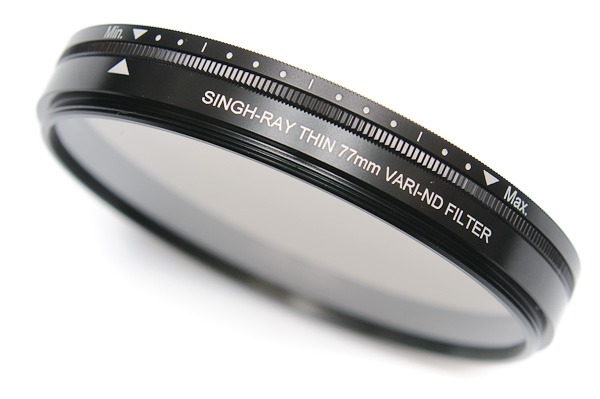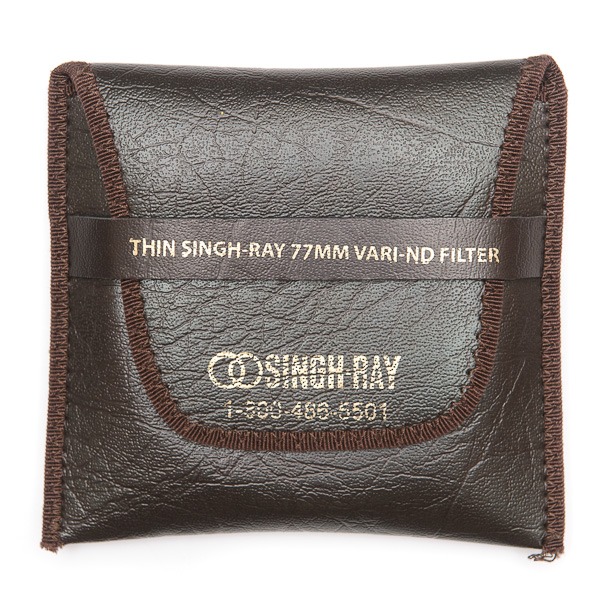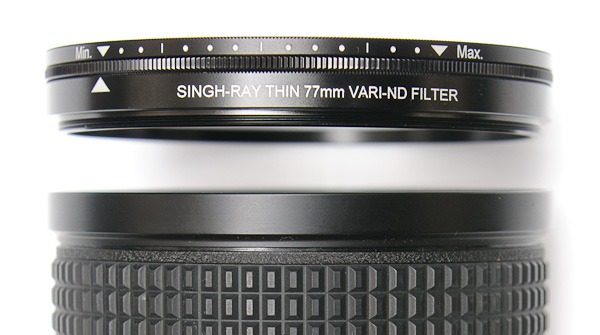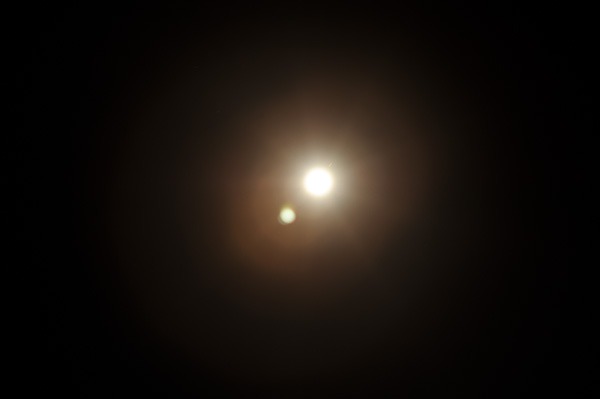Neutral-density filters are a mainstay of landscape and travel photographers desiring long exposure for specific effects like the motion blur of water. However, outside their utility with outdoor photographers, the ND filter has immediate uses for anyone shooting portraits and working with flash photography.
The Singh-Ray Vari-ND is a unique kind of neutral density filter. Unlike most ND filters, the Singh-Ray Vari-ND achieves a 2 to 8-stop range of ND through two different filters sandwiched together, resulting in extreme flexibility from a single unit. As Singh-Ray advertises, their Vari-ND filter is “The only solid ND filter you'll need.”
The Flash Sync Problem
When shooting with flash in bright daylight, there are a couple of problems that become apparent . For one, one has to shoot at or below the x-sync of one's camera, which is generally between 1/200 and 1/250. Even though some speedlights offer a high-speed sync option, the reduction in power that these flashes employ to achieve a HSS is so drastic that it often defeats the entire purpose of trying to ambient light.
Even shooting at the base ISO of one's camera means that a very bright scene will necessitate stopping down to f/11 or even smaller to achieve a proper exposure for the ambient light. When you compound this with the desire to underexpose ambient light and create a hierarchy with an off camera flash like the Nikon SB-900 or a portable lighting system like the Elinchrom Quadra Ranger or Profoto AcuteB 600, the limitations of a 1/250 sync speed become daunting.
Instead of stopping down to f/22, the beauty of an ND filter is the ability to cut multiple stops of light from factoring into the exposure. This not only means that one can avoid stopping down into the zone of diffraction, but it opens up creative opportunities that can help create compelling photos as well.
Whether you want to create a “dark daylight” of dark blue sky or shoot at f/1.4 at high noon, a good neutral density filter is the answer to many a photographers' flash sync woes.
The Only ND Filter You'll Need
Singh-Ray states that their Vari-ND is “The only solid ND filter you'll need,” and they're not far off. Aside from photographers who need less than 2-stops of ND, the 2 to 8 stop range offers enough flexibility to satisfy all but the most demanding and specific uses.
2-stops of ND is the perfect amount for subtle effects, while 8-stops allows you to shoot at f/1.4 at high noon with a sync speed of 1/200 without blowing your exposure white hot.
Moreover, one thing Singh-Ray stands by is the quality of their filters – one reason why the Vari-ND will blow a $300+ hole in your wallet.
Thin vs Regular
Singh-Ray makes two versions of the Vari-ND – the standard-ring version and the thin-ring version. The regular version is 14.2mm thick and the thin is 10.5mm thick. My best recommendation is to skip the standard and go straight to the thin-ring version.
At over a centimeter thick, even the thin-ring is enough cause vignetting below 35mm on a full-frame camera. Besides, if you're already spending $340 on a filter, you might as well spend $390 for the more svelt version.
Design
The design of the Vari-ND filter looks very much like your average polarizer. The Vari-ND features a smoothly rotating front element that lets you dial in different degrees of neutral density, from 2 to 8-stops.
While there are markings on the barrel of the filter, these are not calibrated in any meaningful way. Singh-Ray states that the markings are only so that you can achieve repeatable results and they are not to be used as precise indicators of stops.
Use & Functionality
Using the Vari-ND is a process – for the most part, it's not a set-it-and-forget-it kind of accessory unless you plan on using it at its lowest ND settings only.
Due to the massive amounts of light cut by the Vari-ND filter, the best use of the filter necessitates that you focus at its minimum effect, then reset the filter to shoot. For landscape photographers shooting at hyperfocal settings already, this isn't really an issue at all, but for portrait shoots where composition and shooting distances are rapidly changing, it requires a bit of finesse.
The easiest use of the filter comes without using a lens hood, or using a collapsable lens hood like the Mamiya #2 rubber lens hood.
Since the Vari-ND is only two-stop of light reduction at its minimum, f/2.8 lenses focus just fine without the need to remove this filter. In bright light and with faster lenses, you'll be able to focus with the filter at even higher levels of neutral density.
At 8-stops neutral-density, the frame for all but the brightest scenes is so dark that everything is obscured. Precise framing requires achieving the frame you want before “stopping down” the ND filter. In dimmer ambient situations, a tripod is advisable for the most critical framing.
While the markings on the filter aren't useful for dialing in a specific amount of neutral-density, they are essential for getting even and repeatable results with flash and strobes. Thanks to the markings on the barrel of the Vari-ND, it's easy to set your flash exposure “stopped down” with the filter, open it to 2-stops ND to focus, and then reset the filter to the desired strength.
Examples With The Singh-Ray Variable ND Filter
Killing The Sun
Contrary to its appearance, the above photo wasn't shot in space. Instead, it's a photo of the sun amid a bright blue sky at midday. The exposure was 1/250, f/8, ISO 200 and 8-stops ND with the Singh-Ray Vari-ND filter. Needless to say, this ND filter is enough to turn day into night.
Shooting Wide Open
Translating this into something slightly more applicable to photography, here's an example of how this can work to kill daylight with a portrait:

The above photo is a practical example of how the Singh-Ray Vari-ND can tame daylight in a meaningful way.
Here, the filter was cutting over 4-stops of light, which lower light levels entering the lens enough to shoot the Nikon 85mm f/1.4 at the relatively wide aperture of f/1.8 for a very shallow depth of field, all while dramatically darkening the bright afternoon sky. The real key is that this was all shot at 1/250, the sync Nikon D3.
Without the Vari-ND filter, it would have been impossible to shoot with the same combination of a wide aperture, relatively low shutter speed (for the abundant light), and also throttle down the harsh afternoon sunlight into a gentle accent camera left.
While using high speed sync with speedlights would have enabled one to raise the shutter speed, HSS dramatically decreases flash power, which in turn hugely decreases the flexibility of small flashes and all their benefits.
Shooting Into The Sun
Here's another portrait example of how the Singh-Ray Vari-ND filter can really tame sunlight – in this instance, shooting directly into the glaring, South Beach sun in Miami.

Here, the Vari-ND is working at around four-stops or so – enough to easily tame the sun without completely killing detail in the clouds, and overall keeping things natural for an exposure that would have been impossible otherwise.
Image Quality
The beauty of the Singh-Ray Vari-ND – and the reason for its high price – is the excellent optical quality of this filter. It's color-neutral, so it won't impart color casts to your images while it works – hence why it's called a neutral-density filter.
Moreover, the filter leaves your images sharp. Two slabs of glass or not, sharpness with this filter is a complete non-issue; the quality with this filter is simple there are doesn't degrade the quality of your lenses. In reality, the quality of the lenses you use, your RAW converter, and your sharpening workflow will make more of a difference on image sharpness than the Vari-ND will.

The Good, The Bad & The Ugly
Pros:
- Wide 2 to 8-stop ND range
- Flexibility eliminates need to remote filter to focus for most lenses
- Excellent optical clarity & neutrality
- Daylight becomes your bitch
Cons:
- Thin-ring mount is $390
- Filter vignettes below 28-35mm on full-frame using Nikon 24-70mm f/2.8
- Requires dedicated shooting workflow – not for P&S work
Summary
If you've ever cursed your camera's sync speed, wanted to tame ambient light, or otherwise control your exposures independent of the sun, the Singh-Ray Vari-ND filter is the answer to your prayers.
While it's not cheap by the standards of a filter, the fact is that the Vari-ND is a tool that extends your lighting equipment and its flexibility in such a meaningful way that it's more apt to compare this to another piece of lighting equipment.
As David Hobby, the Strobist Himself, says,
My advice – don't skimp on the ND. The cheap ones are pure crap – and I say that from experience.
I highly recommend the ungodly expensive Singh-Ray Vari ND, which I am pretty sure is manufactured in heaven. It oughtta be, for the price. But it is sharp as hell, neutral and lets yo use any aperture you want.
I couldn't have said it better myself.
Where to Buy – Recommended Retailers
The Singh-Ray Vari-ND is available from BHPhotoVideo.com, where I buy all my photo gear:
- Singh-Ray Vari-ND – 77mm (Thin Mount)
- Singh-Ray Vari-ND – 77mm (Standard Mount)
- Singh-Ray Vari-ND – 82mm (Standard Mount)







